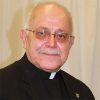Visiting a large Hindu temple in Cambodia, I was overwhelmed by floral tributes, clouds of incense, candles galore and the sheer number of colorful statues. Despite their pantheon of gods, many Hindus consider their religion monotheistic. Lesser deities are incarnations of the One Supreme Brahman.
As I walked past the exotic altars, I had one of those “Aha!” moments. This must be how my Protestant friends felt when they visited my home church of St. Michael’s, in Amsterdam, New York, with our “pantheon” of saints — each in its own way an expression of the love and power of the one true God.
In college I took a comparative religions course. The professor encouraged us to visit local Christian denominations and Jewish synagogues, and he lectured about the worship sites of world religions: Muslim mosques, Hindu ashrams and Buddhist temples.
In Maryknoll’s seminary, we learned how historically different religions influenced one another. Having a rabbi teach New Testament opened our eyes to view the teachings of Jesus from a Jewish perspective. Attending a Sabbath synagogue service, we recognized the prayer, “Blessed are you, O Lord our God, King of the Universe, who created the fruit of the vine…” as the source of our own prayer before consecration.
Also preserved in the liturgy, the Kyrie eleison (Lord, have mercy) in Greek acknowledges our kinship with the Eastern Orthodox. The ancient Catholic Church predated the unfortunate split between Rome and Constantinople in 1054. The Kyrie eleison is a tenant of our liturgical past and an expression of hope in Christian unity.
Our global Church reflects a rich array of responses to the Gospel personified in Jesus Christ. Catholicism’s wealth of tradition draws on the vitality of local expressions of faith. Indeed, throughout our 2,000-year history, the Church has often adopted cultural customs and made them our own. German Christmas trees, Italian Nativity sets, Irish private confessions and Ukrainian pysanky (elaborately colored Easter eggs) have enriched the universal Church.
For centuries, Catholicism confined itself to European customs and expressions of faith. However, contemporary contributions come from other continents. East Africans dance in their liturgies, and the women utter high-pitched ululations of praise. In Korea, Catholics chant the psalms and prayers for the dead (known as “Yeon Do”) in a style that harkens back to the country’s Buddhist past. Latin Americans honor their dearly departed with distinctive cultural customs on El Día de los Muertos (the Day of the Dead), November 2, the universal celebration of All Souls Day. These diverse practices can shed new light on our shared faith.
Regarding world religions, with the declaration of the Second Vatican Council Nostra Aetate (In Our Time), the Church took a huge step, saying it “rejects nothing that is true and holy” in them, and that they “often reflect a ray of that Truth which enlightens all.”
If we remain firmly rooted in our own rich traditions, we have nothing to fear — and much to gain — by experiencing how others worship or express their faith. This, in turn, should challenge and inspire us to more faithfully follow ours. I learned this invaluable lesson at the New York Port Authority bus terminal back in the 1970s. As I awaited my bus, a Hare Krishna devotee approached me and offered me a free copy of The Bhagavad Gita As It Is. I graciously declined, saying, “Thank you, but I read that in college.”
After all these years, the devotee’s response challenges me still. “Oh, you can’t learn about our faith from a book,” she said. “If you want to know about our faith, you must come and see how we live.”
I never took her up on the invitation, but dedicated my life to encouraging Catholics to put our faith into practice. We, too, can say, “If you want to know the Gospels, come see the way we live.”
Featured Image: On All Souls Day in Guatemala, the dead are honored with colorful giant paper kites, a custom that predates the arrival of Christianity to the Americas. (Sean Sprague/Guatemala)
![]()

